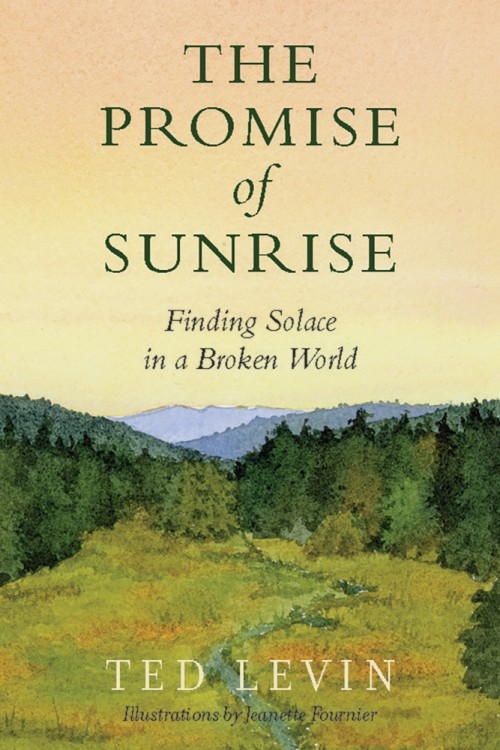by Ted Levin, illustrations by Jeanette Fournier
Green Writers Press, 2025
“Every walk had been substantially different,” writes Ted Levin in The Promise of Sunrise: Finding Solace in a Broken World, “each an endless manuscript multi-authored by clouds, trees, flowers, streams, mammals, amphibians, turtles, and birds.” Self-employed, ever-grieving the loss of his life partner Linny, and with his two adult sons living elsewhere, Levin had settled in to solitary pandemic lockdown in Thetford, Vermont, with a new pattern: every morning he would watch the sunrise and dawn creatures, birds in particular, and then return home to write about his observations. These writings turned into a blog, then a newsletter and this honest yet uplifting book.
After a thoughtful prologue, the book follows Levin through the seasons, beginning with an entry from August 2020, Linny’s birthday. Levin gives space to mourn Linny, as well as to celebrate the fetal heartbeat of his granddaughter-to-be in Colorado. Personal, intimate feelings weave together with Levin’s experience of the natural world, rendered in his unique lyricism: “Chickadee rips breakfast out of a dewy spider web, then sings; reminds me of midwinter when spring was a dream.”
Following this tender entry, the chapters leap back to the first day of his pandemic nature diary, March 18, 2020, and progress through the seasons until the summer of 2021. The entries end on Linny’s birthday. Midway through, Levin relocates from Thetford to a new home he calls Hurricane Hill in Hartford, Vermont. Most chapters include the time of sunrise, a poetic description of the weather, and a survey of which birds and other critters are visible in the landscape. Many chapters are devoted to a particular species, illustrated through entertaining anecdotes, such as his discovery and harvest of five perfect golden morels; the courtship ritual of two nighthawks; a pregnant snapping turtle’s attempt to bury her eggs in the front yard; and a crow’s feast of a dead squirrel, unbothered by the presence of dogs. Levin weaves in to these observations various philosophical, literary, and historical threads, including a recurring appreciation for Rachel Carson’s writings, a defense of Charles Darwin in our politically and religiously divided nation, and well-chosen epigraphs to each entry by the likes of Emily Dickinson, John Burroughs, and Maya Angelou.
Levin is an expert guide to the New England landscape, whom many will know from his other nature books, radio commentary for Vermont Public, and occasional contributions to Northern Woodlands. His deep experience as a birder, photographer, and writer strengthens his observations, and with 43 years as a resident of the region, he has the wide-angle view on the changing seasons, weather patterns, flora, and fauna over time. He considers, as all modern nature writers should, the dramatic effects of the climate crisis on his local landscape, such as the sap of sugar maples in Vermont that flows earlier and earlier each year. Readers will enjoy Levin’s precise and scientifically accurate descriptions of the calls of each bird species, the scent of fox urine, and the affliction of white-nose syndrome on local bat populations. The vibrant flora and fauna in and around a fen that his boys had nicknamed Coyote Hollow serve as more than a backdrop for his thoughts; these nonhuman beings proliferating the pages of this book are his companions in an otherwise isolated time: beavers, marsh wrens, snipe, six species of frogs, kestrels, dragonflies, a golden eagle, deer, turtles, and bats.
Through the pandemic, Levin manages to learn, grow, and enjoy himself in the company of chickadees and bitterns. Levin acknowledges his ever-present loneliness and grief during lockdown, but he also finds beauty and inspiration in routine, quiet naturalism, and attention to detail. Levin’s voice is confident yet humble. Despite his expertise, he doesn’t claim mastery over any topic, but rather offers his thoughts and opinions to the reader in a conversational manner. Jeanette Fournier’s illustrations make for a delightful accompaniment to Levin’s meditations. Her precise renderings of animals in their habitats provide quiet pauses between seasons: goshawk, warbler, hawk, otter, mink, pileated woodpecker, bobcat, black bear, and several portraits of chickadees in various poses.
This accessible and informative book would be a great read for the many folks who found a passion for birding, walking, and wildlife tracking during the pandemic, as well as an engaging collection of stories for more seasoned naturalists.


